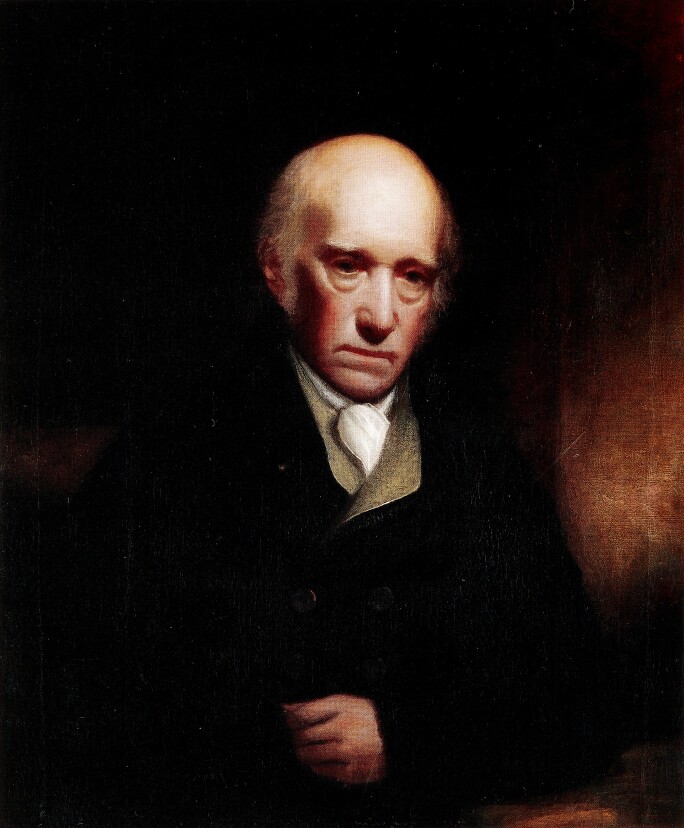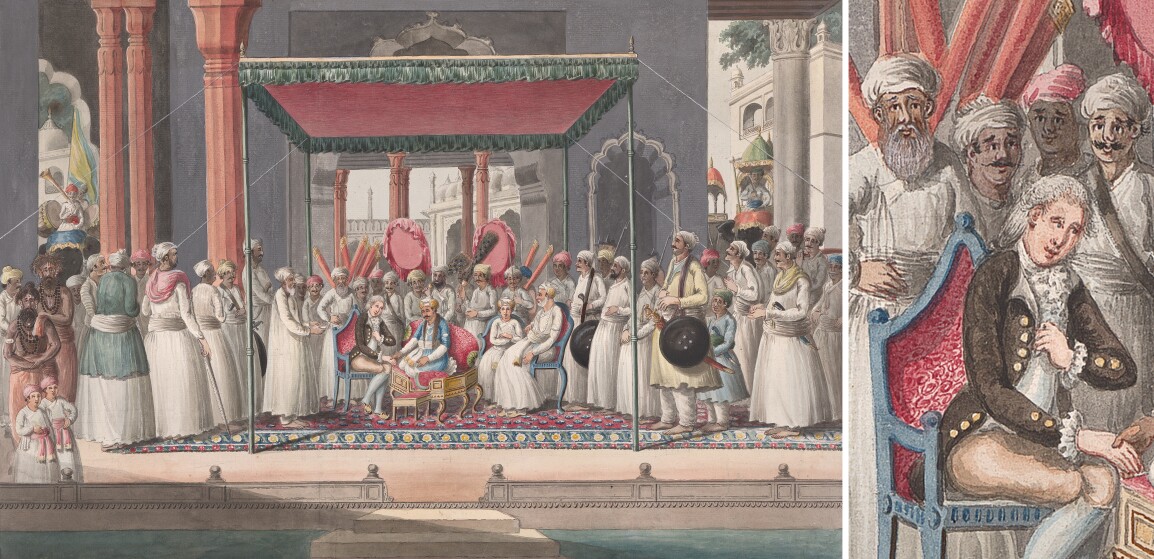Signed and dated 1786, this engaging portrait of an Indian munshi is an exciting addition to William Beechey's œuvre, not just because it only recently re-emerged on the market, but also on account of the sitter's ethnicity, rendering the picture a rarity within the artist's corpus. Though it is impossible to ascertain this man's identity with absolute certainty, he is likely to be Muhammad Samir, who served under the East India Company official Sir John Hadley D'Oyly (1754–1818) and accompanied him to England in 1785. This rediscovered portrait is therefore significant owing to both its visual appeal and its historical importance in documenting the ties between India and Britain during the later eighteenth century.
The painting's small size and panel support are both fairly unusual within Beechey's output and suggest that it was produced on the spot, in front of the sitter, over a short span of time. The sketchy nature of the brushwork—as is particularly evident in the man's hair, moustache and in the background details—supports this hypothesis. The sitter is presented half-length, with his proper left hand resting above his hip, in a pose that evokes a certain degree of authority or confidence, as well as respect from the artist capturing his likeness. He dons a muslin camise tied on his right side, which identifies him as Muslim; gowns tied on the left were traditionally the preserve of Hindus.1 The fabric draped over his proper left shoulder is embellished by colourful embroidery, predominantly yellow in tone, which complements the bright hues of the background, right of centre.
An old label affixed to the panel's reverse is inscribed as follows: Moonshee, an Asiatic / Interpreter – painted by / Sir W. Beechey. Moonshee, spelt munshi in modern times, is a Persian word derived from Arabic, which is used especially in the Indian subcontinent as a respected title for people who have achieved mastery over languages. In the eighteenth century, munshis employed by the East India Company often served as administrators, heads of departments, accountants and secretaries. The munshi depicted here must have travelled to England, as suggested by the inscription at lower right (LONDON) and the fact that Beechey never ventured to India. Though a handful of munshis are known to have made the journey between 1766 and the advent of the nineteenth century, only one is recorded as having done so in the immediate period preceding the present portrait's execution in 1786, which makes his identification as the sitter portrayed here highly likely. In 1785, a munshi named Muhammad Samir made the voyage with Sir John Hadley D'Oyly, who was an East India Company official.

D'Oyly had arrived in Bengal with the Company in 1770, aged sixteen, and had become a great friend of the Governor-General of Bengal, Warren Hastings (1732–1818), whom Beechey painted on a number of occasions (for example, fig. 1).2 He was promoted to the post of Persian Translator to the Bengal Army and subsequently to the Governor-General’s council. In January 1780, he was appointed as British Resident at the Court of Murshidabad, which was considered the most lucrative office in the Company’s service. The ill health of his wife caused D’Oyly to sell his office in early 1785 and return to England, accompanied by his munshi.
Little is known about Samir, nor have any portraits of him been securely identified. His name suggests that he was Sunni,3 though, which correlates with the portrayal of the present sitter, whose facial features are Bengali in appearance. Furthermore, D'Oyly commissioned the British artist George Farington (1752–1788), who was active in Murshidabad for a few years before his death, to paint him in durbar—a public reception—with Mubarak ud-Daula, Nawab of Murshidabad (1770–1793). Given his role as D'Oyly's munshi, Samir would almost certainly have been present at this official event. Frustratingly, Farington's original painting is lost,4 but local Murshidabad artists produced various copies in the 1790s (for example, fig. 2), allowing for a comparison between the figures depicted in attendance and the sitter in this portrait.5 While such analysis must remain speculative on account of the sketchy nature of the Murshidabad watercolours, there is a passing similarity between the facial features of one of the men standing behind D'Oyly and the munshi here represented (fig. 3). Both figures likewise sport comparable styles of turban and moustache, as well as manners of dress.

Right: Fig. 3 Detail from the watercolour depicting Mubarak-ud-Daula, Nawab of Murshidabad, seated in durbar with Sir John Hadley D'Oyly
We are grateful to Charles Greig for his assistance in cataloguing this lot.
1 R. Crill and K. Jariwala (eds), The Indian Portrait, 1560–1860, London 2010, p. 104.
2 Oil on canvas, 75 x 62 cm.; London, Sotheby's, 22 November 2007, lot 55.
3 The Murshidabad Nawabs were Shiite, but various members of the court were Sunni.
4 A smaller version, made for a subsequent Resident, Robert Pott, was also lost.
5 Four copies after the original composition are known: Victoria & Albert Museum, London (inv. no. IS.11:3–1887; gouache on paper, 41.3 x 56.6 cm.); Yale Center for British Art, New Haven (inv. no. B2017.18.3; watercolour on moderately thick, slightly textured, cream laid paper, 35.9 x 53.3 cm.); The British Library, London (Add. Or. 3220–36); and one sold at Bonhams, London, 11 June 2020, for £62,562.50 (gouache on paper; 35 x 53 cm.).